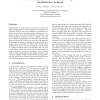Free Online Productivity Tools
i2Speak
i2Symbol
i2OCR
iTex2Img
iWeb2Print
iWeb2Shot
i2Type
iPdf2Split
iPdf2Merge
i2Bopomofo
i2Arabic
i2Style
i2Image
i2PDF
iLatex2Rtf
Sci2ools
ISCA
1997
IEEE
1997
IEEE
Run-Time Adaptive Cache Hierarchy Management via Reference Analysis
Improvements in main memory speeds have not kept pace with increasing processor clock frequency and improved exploitation of instruction-level parallelism. Consequently, the gap between processor and main memory performance is expected to grow, increasing the number of execution cycles spent waiting for memory accesses to complete. One solution to this growing problem is to reduce the numberof cache misses by increasing the e ectiveness of the cache hierarchy. In this paper we present a technique for dynamic analysis of program data access behavior, which is then used to proactively guide the placement of data within the cache hierarchy in a location-sensitive manner. We introduce the concept of a macroblock, which allows us to feasibly characterize the memory locations accessed by a program, and a Memory Address Table, which performs the dynamic reference analysis. Our technique is fully compatible with existing Instruction Set Architectures. Results from detailed simulations of seve...
| Added | 06 Aug 2010 |
| Updated | 06 Aug 2010 |
| Type | Conference |
| Year | 1997 |
| Where | ISCA |
| Authors | Teresa L. Johnson, Wen-mei W. Hwu |
Comments (0)

